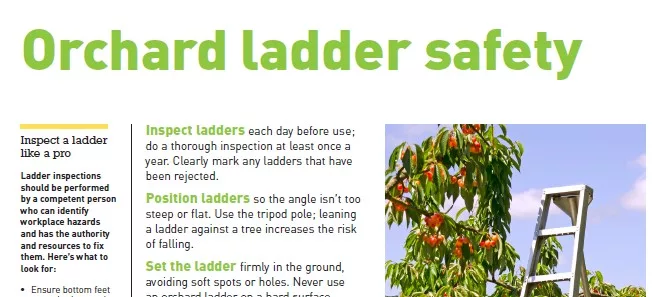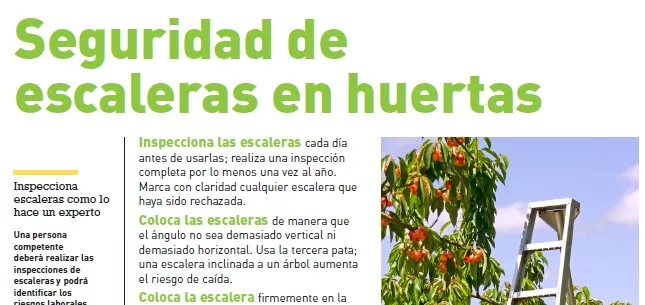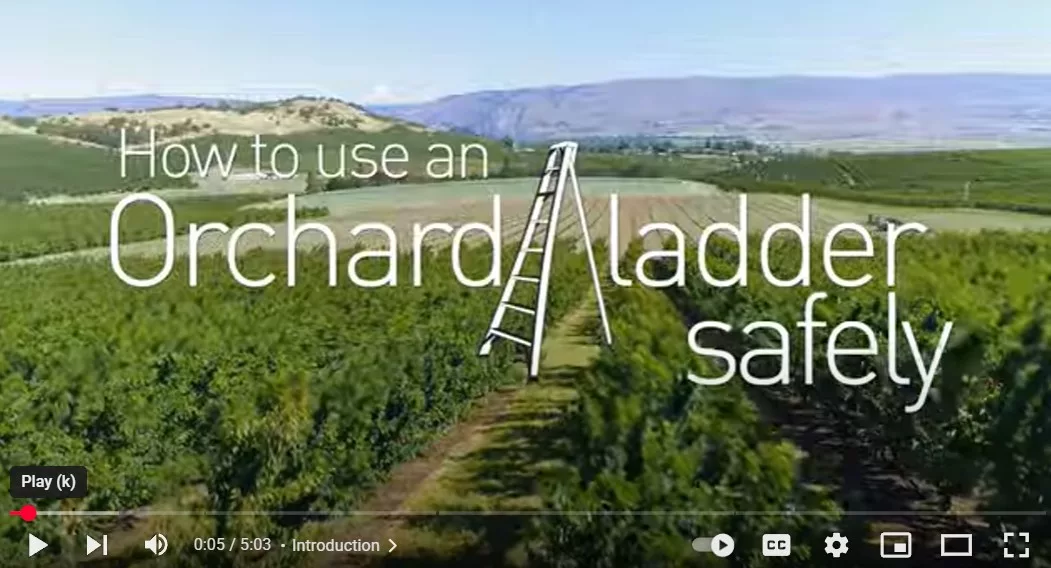
Orchard Ladder Safety
Oregon-OSHA Requirements
Division 4, Subdivision D: Work Surfaces
Orchard ladders are defined as a self-supporting tripod ladder of fixed length. It has two front side rails and a single back supporting leg.
Each step of wooden orchard ladders must have one of the following reinforcements:
- A steel rod (at least 0.16 inches in diameter) that passes through metal washers big enough to prevent pressing into the side rails, and through a truss block between the rod and the center of each step
OR - A metal angle brace on each end firmly secured to the steps and side rails.
OR - Construction of equivalent strength and safety.
- A steel rod (at least 0.16 inches in diameter) that passes through metal washers big enough to prevent pressing into the side rails, and through a truss block between the rod and the center of each step
If the ladder has rod reinforcement, the bottom step must also have a metal angle brace on each end securely attached to the bottom step and side rails.
All steps 27 inches or longer must have a metal angle brace at each end securely attached to the step and rail.
The minimum width between side rails at the highest step for standing, inside to inside, is 9.5 inches. From top to bottom the side rails must spread at least an average of 2.5 inches for each foot of ladder length.
All orchard ladders must have a top with tightly secured wood or metal brackets or fittings, side rails and back leg. The back leg must swing freely without excessive play or wear at the joints.
There must be no dents, breaks or bends in the side rails or rungs.
Prior to assigning an employee to work with orchard ladders, the employer must assure that they have the necessary skills and knowledge to use the ladder safely.
OR
The employer must train new employees about the requirements of this standard and the special procedures and cautions associated with using an orchard ladder.
Do not use orchard ladders longer than 16 feet.
Do not use the top as a step.
Do not allow more than one person at a time on ladders.
Do not step or jump between two or more erected ladders.
Do not use ladders to gain additional height from already elevated surfaces like scaffolds, truck beds, vehicle bodies, tractor scoops or boom truck buckets.
Inspect ladders before each use. Do not use any with defects, loose, warped, bent or broken parts. Tag these ladders, “Dangerous, Do Not Use” until they are fixed.
Do not use metal ladders or wood ladders with vertical metal parts for electrical work or where they may contact electric conductors. This type ladder must have markings reading “WARNING – do not use around energized electrical equipment” or words of equal meaning.

Printable Orchard Ladder Safety Summary
A printable PDF summary of OR-OSHA’s orchard ladder safety rules.

OR-OSHA Division 4 Rule Text: Orchard Ladders
Read OR-OSHA’s Division 4 rules about orchard ladders.

Ag Safety Fact Sheet: Tripod Orchard Ladders
OSHA fact sheet details safety precautions, fall prevention, and injuries and hazards of using tripod orchard ladders.

Orchard Ladder Safety QuickCard
Bilingual OSHA QuickCard includes protecting workers from injuries, preventing falls and inspecting ladders for maintenance.

Orchard Ladder Safety Guide - English
SAIF orchard ladder safety guide, English version.

Orchard Ladder Safety Guide - Spanish
SAIF orchard ladder safety guide, Spanish version.

